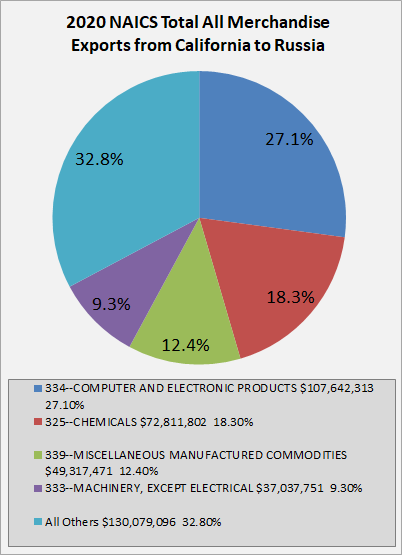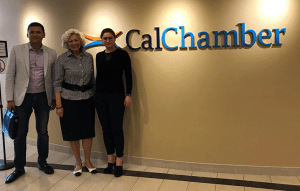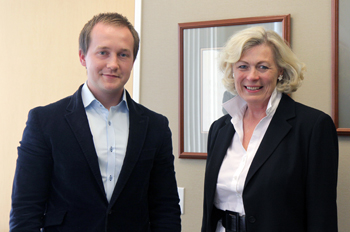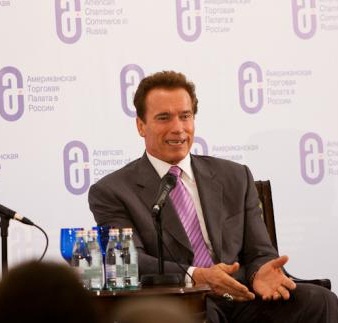Trading Partner Portal: Russia
Overview
|
Economic Impact of Russia’s Invasion into Ukraine |
Trade Overview

After the December 1991 dissolution of the Soviet Union, the Russian Federation became its successor state, inheriting its prominent place on the world stage. Russia boasted a population of 143.53 million and a GDP of $2.17 trillion in 2024, with GDP per capital coming in at $14,889. Trade with Russia around the world, and specifically with the U.S. has changed due to sanctions.
U.S. – Russia Trade
Russia was the United States’ 104th largest export partner, with the U.S. exporting $528 million in 2024, a significant decrease from $1.66 billion in 2022, and $6.388 billion in 2021. In 2024, $187 million of this total was made up of chemicals. This was followed by computers and electronic products ($103 million), processed foods ($62 million), miscellaneous manufactures ($70 million), and apparel & accessories ($19 million).
Imports from Russia totaled $3.01 billion in 2024, a decrease from $4.57 billion in 2023, $14.4 billion in 2022, and $29.64 billion in 2021. Of the 2024 total, $1.78 billion was made up of chemicals, followed by primary metals manufactures ($929 million), transportation equipment ($111 million), wood products ($71 million), and processed foods ($53 million).
California – Russia Trade

California exported $55 million in goods to Russia in 2024, making it California’s 86th largest export partner. $24 million was attributed to computer and electronic products, followed by miscellaneous manufactured commodities ($14 million), chemicals ($5 million), processed foods ($4 million), and products supporting agriculture and forestry ($2 million).
In the same year, California imported $71 million from Russia, a significant decrease from $2.13 billion in 2021, and continued decrease from $82 million in 2023.
Chemicals were the largest segment of these imports, coming in at $36 million. Other top imports included primary metal manufactures ($10 million), transportation equipment ($9 million), wood products ($7 million), and processed foods ($3 million). (US Department of Commerce)
Foreign Direct Investment
In 2024 total foreign direct investment by Russia into the U.S. reached $2.84 billion, while total U.S. direct investment into Russia being $6.62 billion according to SelectUSA. The top industry sectors for Russian FDI are software and IT services, real estate, business services, plastics, chemicals, and transportation. (Select USA)
WTO Trade Policy Review – March 2022
Trade and Investment
Tatarstan Investment Development Agency (TIDA) has a representative office within the United States. The TIDA is a special executive body of the Government of Tatarstan founded in 2011 to carry out investment promotion and facilitation. TIDA is responsible for all international investment and business projects in the Republic of Tatarstan. TIDA focuses its efforts on attracting investment into eight priority sectors of the Tatarstan economy: chemical & petrochemical, machinery & automotive parts, construction & building materials production, agriculture & food processing, medicine & pharmaceuticals, IT & telecommunications, Halal industry, and service industry & tourism.
The Republic of Tatarstan is located about 500 miles east of Moscow, and is geographically similar in size to Ireland. Tatarstan is an oil production and petrochemical center. The population of Tatarstan is over 3.7 million people.
Ernst & Young’s attractiveness survey – Russia 2013
Special Economic Zones in Russia
Russez, January 2013
New Opportunities for US business in Russia
CalChamber’s Trade Issues page on Russia – Permanent Normal Trade Relations
Coalition for U.S. – Russia Trade
News Update
Executive Order — Blocking Property of Additional Persons Contributing to the Situation in Ukraine
White House, March 17, 2014
Comment of Ambassador of Ukraine to the U.S. Olexander Motsyk on the situation in Ukraine
Embassy of Ukraine in the U.S., March 17, 2014
Acting U.S. Trade Representative Sapiro Issues Report Highlighting Russia’s World Trade Organization Compliance
June 19, 2013
U.S. Senate Passes Legislation Ensuring U.S. Access to Russian Market
The U.S. Senate approved California Chamber of Commerce-supported legislation that will enable U.S. companies to compete in the growing and profitable Russian marketplace.
CalChamber Alert, December 14, 2012
CalChamber Praises House Passage and Urges Senate Action to Ensure U.S. Access to Russian Market
CalChamber, November 19, 2012
CalChamber Urges Support for Permanent Normal Trade Relations with Russia
August 21, 2012
California Governor Brown signs-on to support letter for Russia PNTR
July 2012
Joint Statement by the President of the United States of America Barack Obama and the President of the Russian Federation Vladimir Putin
White House, June 18, 2012
Chairman Camp Announces Hearing on Russia’s Accession to the World Trade Organization and Granting Russia Permanent Normal Trade Relations
House Ways and Means, June 18, 2012
Senate Hearing – Russia’s WTO Accession – Administration’s Views on the Implications for the United States
Senate Finance Committee, June 18, 2012
California and the Russian Market
Coalition for US-Russia Trade
Russian Political, Economic, and Security Issues and U.S. Interests
Congressional Research Service, February 2012
The True Cost of Jackson-Vanik
The National Interest, March 29, 2012
Why Approving Permanent Normal Trade Relations with Russia is in the U.S. National Interest
U.S. Chamber of Commerce, March 2012
McFaul Pushes for Trade Status
Moscow Times, March 14, 2012
Russia PNTR Fact of the Week
U.S. – Russia Business Council
World Trade Organization – Ministerial Conference approves Russia’s WTO membership
World Trade Organization, December 16, 2011
The USRBC Applauds Russia’s Formal Invitation to Join the WTO Package
US – Russia Business council, December 16, 2011
The WTO is a multilateral treaty subscribed to by over 150 governments that together account for more than 97 percent of world trade. Over 20 governments are currently negotiating or due to negotiate accession to the WTO. Its basic aim is to liberalize world trade and place it on a secure basis, thereby contributing to economic growth and development and to the welfare of the world’s peoples.
The functions of the WTO are:
- administering WTO trade agreements;
- providing a forum for trade negotiations;
- handling trade disputes;
- monitoring national trade policies;
- offering technical assistance and training for developing countries; and
- cooperation with other international organizations.
The Russian Federation made significant steps towards WTO membership in 2006. The United States and the Russian Federation reached a bilateral trade agreement in November 2006, which cleared a major hurdle to their membership. This follows the 2005 completion of bilateral negotiations on goods with 29 total WTO members, accounting for countries that provide 87 percent of all Russian imports.
On October 1, 2010, US Trade Representative, Ambassador Ron Kirk stated “As President Obama has made clear, having Russia in the rules-based system of the WTO is clearly in the United States’ interest, and we will continue to offer our support as Russia completes the accession process. By reaching bilateral agreement on key issues related to the accession process, Russia can now devote additional energy to addressing remaining steps at the multilateral level. The United States will continue to provide support to Russia as it accomplishes these steps, and to contribute to continued momentum in the process, in cooperation with other members of the WTO.”
As Russia joins the WTO, the United States looks forward to further enhancing bilateral trade relations with Russia.
For more information, please see
CalChamber’s Trade Issues page on the World Trade Organization
The World Trade Organization homepage
Russia Signs Free-Trade Deal With Former Soviet States
The agreement was announced following talks in St Petersburg. The other signature countries are Ukraine, Belarus, Kazakhstan, Armenia, Kyrgyzstan, Moldova and Tajikistan.
BBC News, October 19, 2011
From the US Chamber: On October 20,2011 – nineteen business organizations representing the technology industry and the broader business community, including the Chamber, sent a letter to President Obama to underscore the importance of Russia joining the Information Technology Agreement (ITA) as part of its World Trade Organization (WTO) accession package. The letter states: “We believe it is crucial for Russia to maintain its 2006 commitment to join the ITA as part of its accession package. While we are confident the Office of the U.S. Trade Representative is fully engaged in attempting to bring about this outcome, we believe it is important to directly communicate to you how essential it is to our industry that Russia become an ITA signatory and to underscore with you that the U.S. technology industry’s support of Russia’s accession to the WTO is predicated in large part upon it joining the ITA.”
Fort Ross: The Russia – California Connection
Located approximately 2 1/2 hours above San Francisco, on California’s northern coast line, sits State Historical Park Fort Ross. According to it’s website, “Fort Ross was a thriving Russian-American Company settlement from 1812 to 1841. This commercial company chartered by Russia’s tsarist government controlled all Russian exploration, trade and settlement in the North Pacific, and established permanent settlements in Alaska and California.”
In June 2010, Governor Arnold Schwarzenegger signed a memorandum of understanding (MOU) with the Renova Group of Companies in order to affirm a partnership to support and promote the preservation of California’s Fort Ross State Historic Park, and to raise awareness of its historical and cultural significance.
Gov. Schwarzenegger and the Renova Group of Companies Sign MOU to Preserve Fort Ross State Park
Governor’s Press Release, June 22, 2010
Events
Events
Visit with Representatives from the Republic of Tatarstan Promotes Trade and Investment

On Wednesday, August 15,2018, the California Chamber of Commerce met with representatives from the Tatarstan Investment Development Agency of the Republic of Tatarstan to promote trade and investment. The delegation was led by Ms. Taliya Minullina, CEO of the Tatarstan Investment Development Agency and a Member of the Tatarstan Government in the Russian Federation. She was accompanied by Robert Galiullin, trade representative of the Republic of Tatarstan, and Kirill Gladnev, chief executive assistant.
The Tatarstan Investment Development Agency (TIDA) is a special executive body of the Government of Tatarstan founded in 2011 to carry out investment promotion and facilitation. TIDA is responsible for all international investment and business projects in the Republic of Tatarstan. TIDA focuses its efforts on attracting investment into eight priority sectors of the Tatarstan economy: chemical & petrochemical, machinery & automotive parts, construction & building materials production, agriculture & food processing, medicine & pharmaceuticals, IT & telecommunications, Halal industry, and service industry & tourism. Top Story
| CalChamber Meets with Russian Trade Representative | |
 On September 26, 2012, Roman Zykunov, Trade Representative for the Russian Federation, visited the CalChamber offices to discuss current trade relations between California and Russia. As well as discussing the on-going support from the CalChamber for Russia’s PNTR status, Mr. Zykunov reviewed several measures, recently taken by the Russian government, to improve investment project conditions in their country. This list included facilitating construction procedures, lifting infrastructure restrictions, simplifying procedures for hiring highly qualified expatriates, and improving customs administration. See also www.calchamber.com/RussiaPNTR Mr. Zykunov also informed the CalChamber of tax incentives, the improved court system, privatization of companies with State shareholding, and reduced administrative barriers in general. For the complete, detailed list, please click here. For the complete Alert article, please click here. |
|
| CalChamber Meeting Highlights Russia – California Connection | |
 On November 2, 2010, Mr. Maxim Bezaev visited the CalChamber to discuss California – Russia Trade Relations. Mr. Bazaev is the Head of Projects and Programmes Division, within the Department of International, Foreign Economic and Interregional Relations of the Nizhny Novgorod Region of Russia. The Nizhny Novgorod Region is located in the European center of Russia, approximately 400 km northwest of Moscow. Chief exports of this region are transporation equipment, metallurgy, chemical and petrochemical production and lumber. Nizhny Novgorod also has over 300 high-technology companies and with approximately 43 million people, it is a key Russian consumption market. |
|
| Governor Schwarzenegger Leads Trade Mission to Russia -2010 | |
 In October, 2010 Governor Arnold Schwarzenegger led a trade mission to promote California’s leadership in the high-technology industry and strengthen relations with California’s international partners with stops in Russia and London. In June, the Governor met with Russian Federation President Dmitry Medvedev in Silicon Valley where they discussed Russia’s efforts to generate a technology center similar to Silicon Valley in Skolkovo. The Governor is honoring President Medvedev’s invitation to come to Russia, where he will connect a number of Silicon Valley business leaders and venture capitalists with Russian leaders and business people.
|